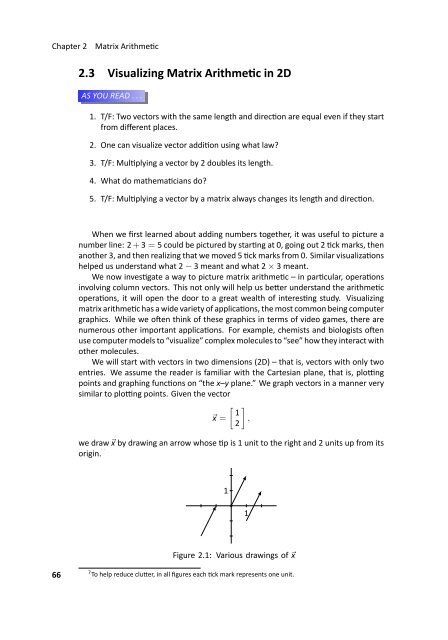Fundamentals of Matrix Algebra, 2011a
Fundamentals of Matrix Algebra, 2011a
Fundamentals of Matrix Algebra, 2011a
Create successful ePaper yourself
Turn your PDF publications into a flip-book with our unique Google optimized e-Paper software.
Chapter 2<br />
<strong>Matrix</strong> Arithmec<br />
2.3 Visualizing <strong>Matrix</strong> Arithmec in 2D<br />
AS YOU READ ...<br />
. . .<br />
1. T/F: Two vectors with the same length and direcon are equal even if they start<br />
from different places.<br />
2. One can visualize vector addion using what law?<br />
3. T/F: Mulplying a vector by 2 doubles its length.<br />
4. What do mathemacians do?<br />
5. T/F: Mulplying a vector by a matrix always changes its length and direcon.<br />
When we first learned about adding numbers together, it was useful to picture a<br />
number line: 2 + 3 = 5 could be pictured by starng at 0, going out 2 ck marks, then<br />
another 3, and then realizing that we moved 5 ck marks from 0. Similar visualizaons<br />
helped us understand what 2 − 3 meant and what 2 × 3 meant.<br />
We now invesgate a way to picture matrix arithmec – in parcular, operaons<br />
involving column vectors. This not only will help us beer understand the arithmec<br />
operaons, it will open the door to a great wealth <strong>of</strong> interesng study. Visualizing<br />
matrix arithmec has a wide variety <strong>of</strong> applicaons, the most common being computer<br />
graphics. While we oen think <strong>of</strong> these graphics in terms <strong>of</strong> video games, there are<br />
numerous other important applicaons. For example, chemists and biologists oen<br />
use computer models to “visualize” complex molecules to “see” how they interact with<br />
other molecules.<br />
We will start with vectors in two dimensions (2D) – that is, vectors with only two<br />
entries. We assume the reader is familiar with the Cartesian plane, that is, plong<br />
points and graphing funcons on “the x–y plane.” We graph vectors in a manner very<br />
similar to plong points. Given the vector<br />
[ ] 1<br />
⃗x = ,<br />
2<br />
we draw ⃗x by drawing an arrow whose p is 1 unit to the right and 2 units up from its<br />
origin. 7 .<br />
1<br />
.<br />
1<br />
.<br />
Figure 2.1: Various drawings <strong>of</strong> ⃗x<br />
66<br />
7 To help reduce cluer, in all figures each ck mark represents one unit.

















